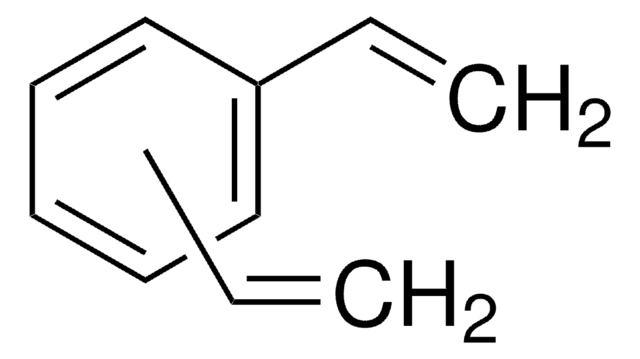572500
Fullerene-C60
sublimed, 99.9%
Synonyme(s) :
Buckminsterfullerene
About This Item
Produits recommandés
Niveau de qualité
Pureté
99.9%
Forme
sublimed
Caractéristiques du produit alternatif plus écologique
Design for Energy Efficiency
Learn more about the Principles of Green Chemistry.
sustainability
Greener Alternative Product
Pf
>280 °C (lit.)
Solubilité
organic solvents: soluble
organic solvents: soluble
Énergie orbitale
HOMO 6.1 eV
LUMO 4.5 eV
Performance des dispositifs OLED
ITO/CuPc/NPD/Alq3/C60/Mg:Ag
ITO/NPD/Alq3/C60/LiF:Al:Ag
ITO/TPD/Alq3/C60/LiF/Al/Ag
Autre catégorie plus écologique
, Enabling
Chaîne SMILES
c12c3c4c5c1c6c7c8c2c9c%10c3c%11c%12c4c%13c%14c5c%15c6c%16c7c%17c%18c8c9c%19c%20c%10c%11c%21c%22c%12c%13c%23c%24c%14c%15c%25c%16c%26c%17c%27c%18c%19c%28c%20c%21c%29c%22c%23c%30c%24c%25c%26c%31c%27c%28c%29c%30%31
InChI
1S/C60/c1-2-5-6-3(1)8-12-10-4(1)9-11-7(2)17-21-13(5)23-24-14(6)22-18(8)28-20(12)30-26-16(10)15(9)25-29-19(11)27(17)37-41-31(21)33(23)43-44-34(24)32(22)42-38(28)48-40(30)46-36(26)35(25)45-39(29)47(37)55-49(41)51(43)57-52(44)50(42)56(48)59-54(46)53(45)58(55)60(57)59
Clé InChI
XMWRBQBLMFGWIX-UHFFFAOYSA-N
Vous recherchez des produits similaires ? Visite Guide de comparaison des produits
Description générale
Application
Mention d'avertissement
Warning
Mentions de danger
Conseils de prudence
Classification des risques
Eye Irrit. 2 - STOT SE 3
Organes cibles
Respiratory system
Code de la classe de stockage
11 - Combustible Solids
Classe de danger pour l'eau (WGK)
WGK 3
Point d'éclair (°F)
Not applicable
Point d'éclair (°C)
Not applicable
Équipement de protection individuelle
dust mask type N95 (US), Eyeshields, Gloves
Faites votre choix parmi les versions les plus récentes :
Déjà en possession de ce produit ?
Retrouvez la documentation relative aux produits que vous avez récemment achetés dans la Bibliothèque de documents.
Les clients ont également consulté
Articles
The conductivity of organic semiconductors can be increased, and the barriers to charge-carrier injection from other materials can be reduced, by the use of highly reducing or oxidizing species to n- or p-dope, respectively, the semiconductor.
Silylethyne-Substituted Pentacenes
The union of distinct scientific disciplines is revealing the leading edge of Nanotechnology.
Flexible electronic circuits, displays, and sensors based on organic active materials will enable future generations of electronics products that may eventually enter the mainstream electronics market.
Contenu apparenté
Batteries, fuel cells, and supercapacitors rely on electrochemical energy production. Understand their operation and electron/ion transport separation.
Les batteries, supercondensateurs et piles à combustible sont des dispositifs de stockage et de conversion d'énergie, basés sur la production d'énergie électrochimique au niveau d'une interface électrode/électrolyte et d'une séparation assurant le transport d'électrons/ions.
Notre équipe de scientifiques dispose d'une expérience dans tous les secteurs de la recherche, notamment en sciences de la vie, science des matériaux, synthèse chimique, chromatographie, analyse et dans de nombreux autres domaines..
Contacter notre Service technique



![[5,6]-Fullerene-C70 98%](/deepweb/assets/sigmaaldrich/product/structures/316/205/6bbd4872-2192-4042-bd5c-a2b6c4edba43/640/6bbd4872-2192-4042-bd5c-a2b6c4edba43.png)


![[6,6]-Phenyl C61 butyric acid methyl ester >99.9%](/deepweb/assets/sigmaaldrich/product/structures/359/221/d990c746-0960-4c69-bf76-fe09b193824d/640/d990c746-0960-4c69-bf76-fe09b193824d.png)


![[6,6]-Phenyl C71 butyric acid methyl ester 99%](/deepweb/assets/sigmaaldrich/product/structures/716/624/9fb9f2f0-ae99-429f-8d3a-b12267976a4d/640/9fb9f2f0-ae99-429f-8d3a-b12267976a4d.png)